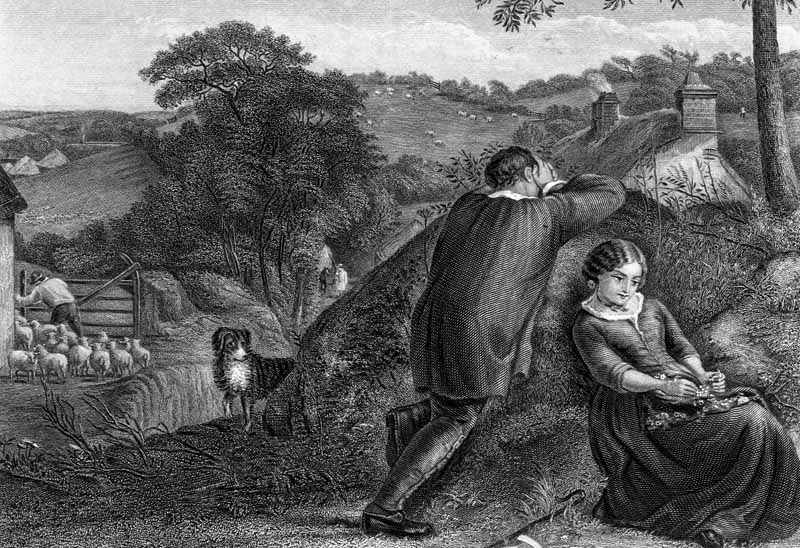AN ANTIQUE STEEL ENGRAVING MADE IN the 1860s !! ITEM IS OVER 125 YEARS OLD! VERY OLD WORLD! INCREDIBLE DETAIL!.
BIOGRAPHY OF ARTIST: James Clarke Hook (1819-1907) was an English painter, was born in London on the 21St of November 1819. His father, James Hook, a Northumbrian by descent, Judge Arbitrator of Sierra Leone, married the second daughter of Dr Adam Clarke, the commentator on the Bible, who gave to the painter his second name. Young Hook's first taste of the sea was on board the Berwick smacks which took him on his way to Wooler. He drew with rare facility, and determined to become an artist; and accordingly, without any supervision, he set to work for more than a year in the sculpture galleries of the British Museum. In 1836 he was admitted a student of the Royal Academy, where he worked for three years, and elsewhere learned a good deal of the scientific technique of painting from a nephew of Opie. His first picture, called "The.Hard Task," was exhibited in 1837, and represented a girl helping her sister with a lesson. Unusual facility in portraiture and a desire to earn his own living took the student into Ireland to paint likenesses of the Waterford family and others; here he produced landscapes of the Vale of Avoca, and much developed his taste for pastoral art; later, he was similarly engaged in Kent and Somersetshire. In 1842 his second exhibited work was a portrait of " Master J. Finch Smith ": in this year he gained silver medals at the Royal Academy, and in 1843 he was one of the competitors in the exhibition of cartoons in Westminster Hall, with a io by 7 ft. design of "Satan in Paradise." In 1844 the Academy contained a picture of a kind with which his name was long associated, an illustration of the Decameron, called "Pamphilius relating his Story," a meadow scene in bright light, with sumptuous ladies, richly clad, reclining on the grass. The British Institution, 1844 and 1845, set forth two of Hook's idylls, subjects taken from Shakespeare and Burns, which, with the above, showed him to be cultivating those veins of romantic sentiment and the picturesque which were then in vogue, but in a characteristically fresh and vigorous manner. "The Song of Olden Times" (Royal Academy, 1845) marked the artist's future path distinctly in most technical respects. It was in this year Hook won the Academy gold medal for an oil picture of "The Finding the Body of Harold." The travelling studentship in painting was awarded to him for "Rizpah watching the Dead Sons of Saul" in 1846; and he went for three years to Italy, having married Miss Rosalie Burton before he left England. Hook passed through Paris, worked diligently for some time in the Louvre, traversed Switzerland, and, though be stayed only part of three years in Italy, gained much from studies of Titian, Tintoret, Carpaccio, Mansueti and other Venetians. Their influence thenceforth dominated the coloration of his pictures, and enabled him to apply the principles to which they had attained to the representation (as Bonington before him had done) of romantic subjects and to those English themes of the land and sea with which the name of the artist is inseparably associated. " A Dream of Ancient Venice" (R.A., 1848)- the first fruit of these Italian studies-" Bayard of Brescia" (R.A., 1849), "Venice" (B.I., 1849) and other ~crorks assured for Hook the Associateship of the Royal Academy in 1851. Soon afterwards an incomparable series of English subjects was begun, in many pastorals and fine brilliant idylls of the sea and rocks. "A Rest by the Wayside" and "A Few Minutes to Wait before Twelve o'clock " proved his title to appear, in 1854, as a new and original painter. After these can~e "A Signal on the Horizon"(1857), "A Widow's Son going to Sea," "The Ship-boy's Letter," "Children's Children are the Crown of Old Men," "A Coast-boy gathering Eggs," a scene at Lundy; the perfect "Luff, Boy!" (1859), about which Ruskin broke into a dithyrambic chant, "The Bi-ook," "Stand Clear! " " 0 Well for the Fisherman's Boy!" (1860), " Leaving Cornwall for the Whitby Fishing," "Sea Urchins," and a score more as fine as these. The artist was elected a full Academiciaii on the 6th of March 1860, in. the place of James Ward. He died on the I4th of April 1907.
We pack properly to protect your item! Please note: the terms used in our auctions for engraving, heliogravure, lithograph, print, plate, photogravure etc. are ALL prints on paper, NOT blocks of steel or wood. "ENGRAVINGS", the term commonly used for these paper prints, were the most common method in the 1700s and 1800s for illustrating old books, and these paper prints or "engravings" were inserted into the book with a tissue guard frontis, usually on much thicker quality rag stock paper, although many were also printed and issued as loose stand alone prints. So this auction is for an antique paper print(s). | |
